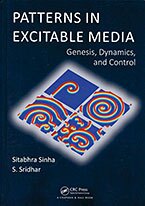Patterns in Excitable Media: Genesis, Dynamics, and Control
DOI: 10.1063/PT.3.3082
Many patterns in nature, from the organization of vegetation in arid ecosystems to stripes and spots on animal skin and fur, can be described with standing waves produced by reaction-diffusion equations. Other solutions to reaction-diffusion equations, however, can lead to dynamical waves—for example, in predator–prey populations, the heart, and the brain. The above systems are all examples of excitable media— dynamical systems with domains that can be individually “excited” and that also interact with each other, potentially spreading the excitation along.

In their new book, Patterns in Excitable Media: Genesis, Dynamics, and Control, Sitabhra Sinha and S. Sridhar provide a good introduction for undergraduates and early graduate students to the dynamic formation of patterns in reaction-diffusion systems. Because an understanding of excitable media is applicable to so many disciplines—including physics, biology, chemistry, physiology, math, and biomedical engineering—the book should be of interest to a wide variety of students.
Patterns in Excitable Media is divided into three parts. The first begins with a detailed description of excitable media: Specific examples considered use mathematical models that range from simple and generic to complex. Part one continues with descriptions of the different types of wave dynamics that the mathematical models can produce in one and two dimensions. Particular emphasis is given to spiral waves and their transition to chaos. This part concludes with an image gallery of biological and chemical examples in which spiral waves are readily observed.
The second part focuses on the dynamics and instabilities of waves, particularly spiral waves, in the presence of heterogeneities that can either be static, arising from the domains’ structure and coupling, or dynamic, emerging as a function of the medium’s nonlinear dynamics. In several examples, the authors present numerical simulations in which the degree and nature of the inhomogeneities are modulated and in which the different regimes that arise are illustrated.
The final part of the book is dedicated to methods for controlling spatially disorganized patterns such as those responsible for deadly cardiac arrhythmias. Previous chapters showed different mechanisms that can destabilize propagating waves in excitable media and turn them into single or multiple spiral waves with chaotic behavior. This final part presents a series of control methods, each specifically designed to target a particular destabilization mechanism. The strength of this part—and of the book—is that it demonstrates the importance of understanding a system’s dynamics and the physics behind an instability before designing an appropriate and successful control method.
As acknowledged in the preface, Patterns in Excitable Media is mostly a collection of the authors’ publications, adapted and expanded into book form. That approach comes with advantages and disadvantages. Content from publications introduces relatively fresh material and exposes readers to some of the latest research themes. However, the book chapters are a bit disconnected. On many occasions, the background added to convert articles into chapters is rather thin. And in several instances, sections read more like checklists of topics that needed to be covered than as full explanations of important concepts.
Moreover, the book left me with three disappointments. The first is the low resolution and overall poor quality of many images; that’s a pity, because one of the great appeals of patterns in excitable media is the impressive images they can generate. Second, the book’s title promises much more than the content delivers; the majority of the book focuses on one system, cardiac dynamics. And third, the book’s back cover sets the reader up for discussion of high-performance supercomputer applications and computer-code examples. However, only two pages are dedicated to parallelization, and only five simple codes, all written in Matlab, are supplied: three codes for zero-dimensional excitable models and two very simple 2D codes.
Nevertheless, I would recommend Patterns in Excitable Media as supplemental material for multidisciplinary courses that deal with nonlinear dynamics, chaos, computational physics, and applied math.
More about the Authors
Flavio H. Fenton is an associate professor of physics at the Georgia Institute of Technology in Atlanta. He conducts research on complex systems and cardiac dynamics using theory, computer simulations, and experiments.
Flavio H. Fenton. Georgia Institute of Technology, Atlanta.




